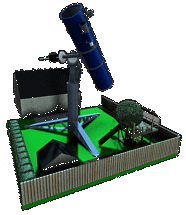 |
 |
|
Filter Research |
Go back to HOMEPAGE
 |
 |
|
Filter Research |
Go back to HOMEPAGE
|
Deep-Sky (Band Pass) Filter Research Deep-sky filters are potentially far more useful than colour filters, at least that is if you plan to observe anything other than the moon and planets. This is doubly true if you observe primarily in an urban setting. Researching and buying colour filters is relatively easy since they are inexpensive, and even though there are several manufacturers, they all make the same standard set of Wratten colours. Deep-sky filters on the other hand are in a very muddled and confusing market due to the myriad of options that are available. The names and descriptions used to describe the available filters are kind-of standardized but not enough to make a clear decision on what filter is best for what. The only way to really understand the strengths and weaknesses of a filter is to look at its spectral response curve…here we go again! Opposite to what I found for colour filters, pretty much every deep-sky filter maker publishes a spectral response curve of some sort. Most people do not find these curves all that useful since they do not always show things like desirable wavelengths for nebulae viewing or undesirable wavelengths for avoiding light pollution. Also, the big thing (for me anyway) is that there is no place one can go to compare response curves from one filter to the other.
Figure 12 Example Manufacturer Supplied Spectral Response Curve My interest in these filters came originally from a desire to make an informed purchase since these filters tend to be rather expensive. I wanted to make sure that I was: getting good bang for my buck, and getting the correct performing filter for what I wanted to use it for. To do that I needed to compare the available filters to each other directly using the published spectral response data. So I painstakingly collected spectral response curves for every filter I could find, converted them to x-y data by methodically tracing each image by hand in a drafting software, then replotting the curves together in logical groups. Since my interest is in visual observation, I have limited my research to filters that are marketed for visual use or that could be used as such. In the end I was very surprised at how many different types of filters I found; 18 different manufacturers, and 64 different filters. Included in my research are the following filters and filter manufacturers (note filter names are abbreviated below, see summary table for full filter names):
I know for a fact that there are other filters out there, but I have not included them because I was not able to find spectral response data for them. Specifically I was not able to find data for Antares (O-III & Narrowband Nebular) and Televue (Mars-A & Mars-B). There are likely others I am not even aware of. Also, the curves I have for Sirius Optics are provided from Island Eyepiece out in BC who were very helpful, as the company Sirius Optics itself is no longer in business. Finally Celestron brand filters, from what I have been able to determine, are made by Baader Planetarium and are therefore assumed to be equivalent in performance. Manufacturer provided spectral response data suggests that this assumption is correct. I have summarized all the basic info on the filters and filter manufacturers in a master table that you may download if you like <.PDF> (.XLS is available upon request). The table includes my calculation of photopic and scotopic transmissivity (see Human Eye chapter for more on my methodology), as well as my own categorization for each of the filters. My logic for grouping the filters into 11 categories is explained in the table below.
Table 5 Deep-Sky Filter Category Definitions I’ll talk in the next chapter about what each category of filter is probably best used for. For now let’s have a look at how these filters compare. Below are spectral response plots for each of the 11 categories described above. The similarities and differences between the various filters are more easily viewed now using these plots. I apologize in advance if there are inaccuracies in my data. My method of redigitizing image files has weaknesses, but this was the only way to get the data in a usable form. PDF or XLS versions of this data are available upon request. Figure 13 Deep-Sky Filter Spectral Response Comparison Plots Well all this spectral data is nice but...zoooey! how am I going to pick a filter now? I have so many choices, what do I really want or need?… <next>
|
|||||||||||||||||||||||||
|
Introduction - The Human Eye - Planetary Filter Research - Using Planetary Filters - Deep-Sky Filter Research - Using Deep-Sky Filters - References |
Go back to HOMEPAGE
Last updated: 07-Mar-12
|
Copyrights to all content from the webpages hosted here belongs to Jim Thompson. Nov. 2009. |